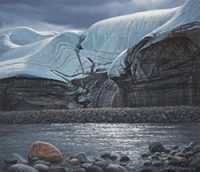
Up Close by Corey Trépanier
Into the Arctic is a traveling exhibit that’s at the Dennos Museum until the end of the calendar year 2017. The exhibit provides incredible vistas of northern Canada painted en plein air under sometimes incredible conditions. In the videos that accompany the exhibit by Cory Trépanier — we see his family, his friends, his guides and many moments of natural beauty.
I love taking creative writing classes to the museum and asking them to engage in ekphrasis to stimulate a story they didn’t know they needed to tell or a poem that they may never have otherwise written. Today I asked my class to write the story of the painting or sculpture they chose. Ekphrasis is one of my go-to places for inspiration when I find myself experiencing writer’s block. The Dennos is such a wonderful, ever-changing resource for new and surprising works of art. I’m so thankful to work on a campus where I can walk over to an actual art museum on my lunch break (and I ought to do so more often than I do.)
Walking into the Trépanier exhibit with my students was intense–I knew it was there but I had not seen it yet myself. Several of my students asked if these were photographs–nope, oil on canvas, mostly. Tors, a natural rock feature created by weathering, sprinkle Trépanier’s mountain landscapes, which are also cut by glaciers, icebergs, and rivers trending toward waterfall. The landscapes, captured by Trépanier, reignite my desire to see the Arctic Circle.
I had a wonderful, instructive conversation with a student who is actually a working artist. She and I were remarking about how the lighting in the study pieces captured the spirit of the mountains in a way that gripped us, moreso than the larger pieces done later, in the studio. One in particular (Arctic Sentinel) felt like the light was coming in wrong because of the light in the sky and the angle of the light on the hillsides; another, Wilberforce, felt like the water was too calm in the large work, while it broiled as it came to the brink of the falls in the study. The study pieces, on 16’ canvases, were beyond beautiful to behold. The larger paintings were striking, but the smaller ones, painted out in and among and against the forces of nature, were emotional.
While my students were writing stories and poems inspired by different paintings, prints, and sculptures, I sat on the floor and contemplated a verdant empty valley with small dark trees dotting the hillside. This painting, Tombstone Valley, made me want to walk right inside and listen to the sounds of the wind, the animals (which are notably absent from these paintings), and of boots crunching on gravelly landscape. A student asked me if it was okay that she wrote a poem called Where the Rivers Run Wild instead of a story–of course I said yes. The thing about art and writing is that both are areas where the artist/writer can be surprised by his or her creation and the work will often better for the surprise. It’s one of the reasons I love the rotating collections–I take students to the Dennos semester after semester, and they and I am always surprised.
At Sundown at Wilberforce, I stood for ten minutes or so contemplating the waterfall on the left, and then suddenly noticed the rock pools shrouded in mist on the right of the painting–I imagined the dual waterfall during spring runoff when the snowmelt swells rivers, and then went into the painting as it was, and spent some time in my imagination clambering around on the rocks with my delighted children exclaiming about their finds. What turtles, fish, salamanders and insects would I find there? What mosquitoes would find me? As one who is acquainted with the Canadian Shield, the Canadian Arctic calls to me with a siren song, out from Trépanier’s paintings and asking me to come walk and see it Up Close.
I love visiting the Dennos with my students and seeing new things through new eyes. Today I learned about how to create a cloud shadow in the landscape–add blue or purple to the green you’ve painted above the shadow-line–and I learned, again, the power of changing the environment to spur creativity.

